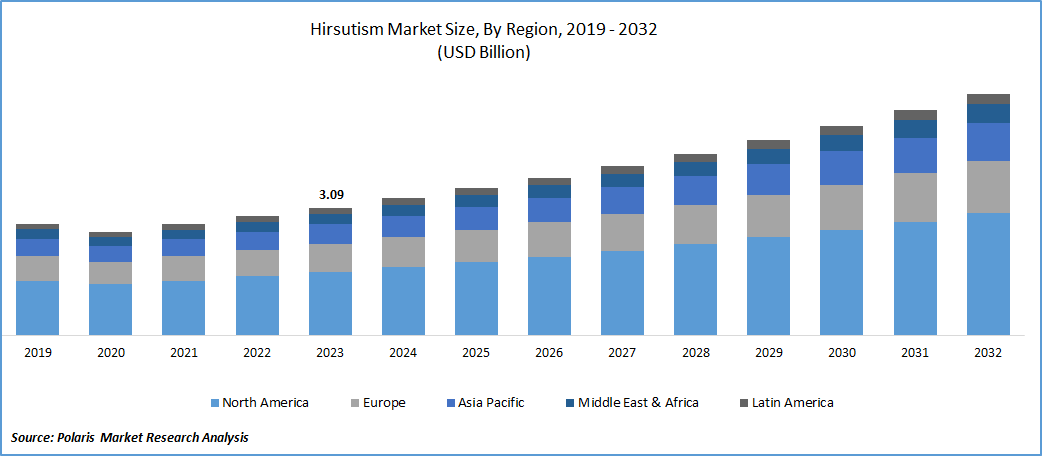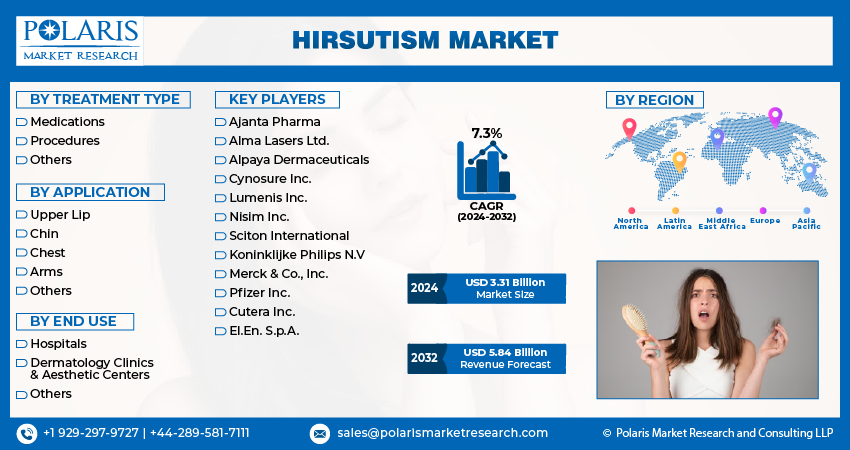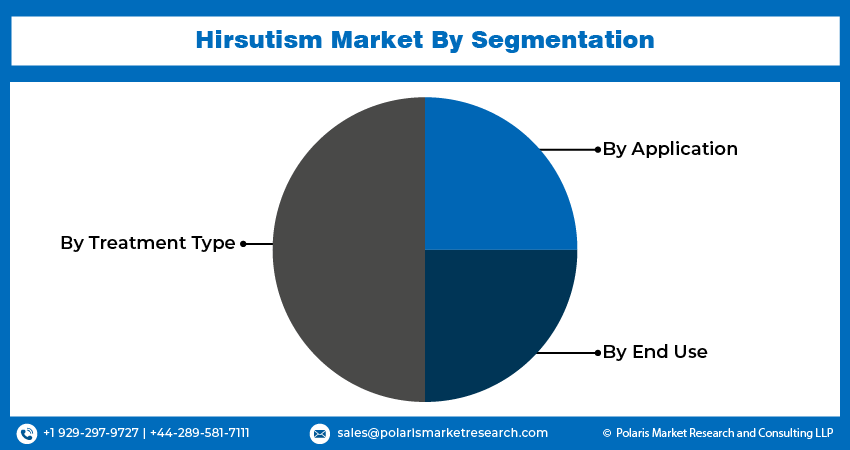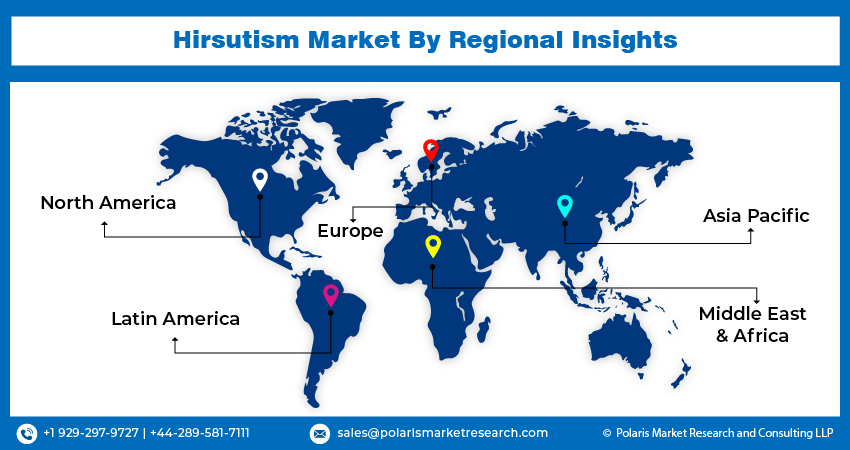
Hirsutism Market Share, Size, Trends, Industry Analysis Report, By Treatment Type (Medications, Procedures, Others), By Application, By End-use, By Region, And Segment Forecasts, 2024 - 2032
- Published Date:Feb-2024
- Pages: 117
- Format: PDF
- Report ID: PM4247
- Base Year: 2023
- Historical Data: 2019-2022
Report Outlook
The global hirsutism market was valued at USD 3.09 billion in 2023 and is expected to grow at a CAGR of 7.3% during the forecast period.
The market is experiencing growth primarily due to the increasing prevalence of hirsutism among women. As reported by the American Academy of Family Physicians, approximately 7% of women are affected by hirsutism, leading to a substantial economic burden exceeding USD 600 million annually in the United States. The market is further driven by cosmetic and psychological concerns associated with unwanted hair, as well as the rising prevalence of polycystic ovary syndrome. These factors collectively contribute to the anticipated growth of the market in the forecast period.

To Understand More About this Research: Request a Free Sample Report
Polycystic Ovary Syndrome (PCOS) is a prevalent hormonal disorder affecting women of reproductive age. The World Health Organization (WHO) reports an estimated PCOS prevalence between 8-13%, with up to 70% of cases remaining undiagnosed. PCOS is characterized by various symptoms, including hirsutism, excess androgen production, irregular periods, and infertility. The increasing prevalence of PCOS poses a significant public health concern, driving the growth of the market. Ongoing research into the underlying causes of PCOS is enhancing understanding and leading to the development of new treatments for the condition. This progress contributes to more effective hirsutism treatments, further fueling market growth.
Obesity stands as a significant risk factor for Polycystic Ovary Syndrome (PCOS). The Centers for Disease Control and Prevention (CDC) report reveals varying obesity prevalence among women across age groups, with 39.7% of women aged 20-39, 43.3% of women aged 40-59, and 43.3% of women aged 60 and over classified as obese. With the ongoing upward trend in obesity rates, it is anticipated to contribute to a further escalation in PCOS prevalence and, consequently, an increased incidence of hirsutism.
A September 2021 study by Yale et al., as reported in the NCBI article, investigated the relationship between hyperandrogenic women, including those with polycystic ovary syndrome (PCOS) and hirsutism, and COVID-19. The study found that COVID-19-positive women with hyperandrogenism, including PCOS and hirsutism market, had hospitalization rates ranging from 4.5% to 8%, with no significant increase in mortality rates compared to those without these conditions (11.4%-11.7%). The study did not identify notable associations between the use of therapeutics like spironolactone, estradiol, and metformin and the rates of COVID-19 infection or hospitalization among these women.
The research report offers a quantitative and qualitative analysis of the Hirsutism Market to enable effective decision-making. It covers the key trends and growth opportunities anticipated to have a favorable impact on the market. Besides, the study covers segment and regional revenue forecasts for market assessment.

Industry Dynamics
Growth Drivers
Technological Advancements in Hair Removal Devices
Advancements in technologies related to hair removal, such as laser and light-based devices, may enhance the efficacy and safety of hirsutism treatments, attracting more patients.
The increasing prevalence of cosmetic procedures, driven by growing beauty consciousness, is fueling the demand for laser hair removal. As individuals express a desire for smoother, hair-free skin, laser hair removal has become a favored solution to address the cosmetic and psychological concerns associated with unwanted hair. According to the International Society of Aesthetic Plastic Surgery (ISAPS), hair removal procedures accounted for a substantial share of aesthetic treatments in 2022, with over 1.8 million procedures performed on both women and men. This significant rise in hair removal procedures underscores the escalating demand for effective and long-term solutions to unwanted hair.
Hirsutism, characterized by excessive hair growth in women, particularly on the face, chest, and back, causes significant distress and impacts self-esteem. Unwanted hair contributes to feelings of embarrassment, self-consciousness, and social anxiety, affecting emotional well-being. Laser based hair removal helped in the unwanted hair associated with the hirsutism. It targets hair follicles, reducing hair growth and providing long-lasting results. Due to its effectiveness & convenience, laser-based hair removal has gained popularity among individuals seeking to restore confidence with their appearance, thereby contributing to market growth.
Report Segmentation
The market is primarily segmented based on treatment type, application, end use, and region.
|
By Treatment Type |
By Application |
By End Use |
By Region |
|
|
|
|
|
|
To Understand the Scope of this Report: Speak to Analyst
Medications Segment Accounted for the Largest Market Share in 2023
Medications segment accounted for the largest share. Among the top medications employed for hirsutism treatment are birth control pills, androgen-suppressing medications, low-dose steroid medications, and insulin-lowering medications. According to information from the Cleveland Clinic, birth control pills stand out as the most frequently prescribed medications for hirsutism treatment. These pills effectively lower androgen levels in women, regulate the menstrual cycle and provide contraceptive benefits.
Procedures segment will grow rapidly. Laser therapy stands out as a widely employed procedure. As per information from Ethos Spa, laser hair removal utilizes pulsed light to target hair follicles, leading to a substantial reduction in hair regrowth, up to 90%. This procedure offers hirsutism patients a convenient way to manage excessive hair without the need for consistent maintenance. Over time, regular use of laser hair removal further diminishes hair regrowth, contributing to the growth of the hirsutism market.
By Application Analysis
Upper Lip Segment Held the Significant Market Share in 2023
Upper lip segment held the significant market share. Facial hair in women exhibits variations in volume and type. As highlighted in the Clinique Matrice article, it is commonplace for the women to possess sparse facial hair along the outer corners of the jaw line & upper lip. This natural facial hair is commonly referred to as peach fuzz. Notably, women from European countries such as Italy & Greece, as well as those from the Indian subcontinent, often exhibit more facial hair compared to women in other regions of the world.
Chin segment is expected to gain substantial growth rate. As outlined in a Healthline article, it is common for most females to have short hair on their faces, but some may exhibit more noticeable hair on their chins, influenced by factors such as genetics or age. The onset of menopause can lead to increased chin, facial, or neck hair. Studies indicate variations in androgen levels and corresponding body and facial hair among different racial groups. These insights underscore the efficacy and long-lasting benefits of laser therapy as a potential treatment for excessive hair growth on the chin.

Regional Insights
North America Dominated the Global Market in 2023
North America dominated the global market. Region’s growth is primarily due to rise in the number of hirsutism cases, the presence of well-established dermatology clinics, and a growing pool of skilled professionals in the region. According to a May 2023 article from the National Center for Biotechnology Information (NCBI), approximately 10% of women in the United States are affected by hirsutism, making it the most frequently diagnosed endocrine disorder.
The Asia Pacific will grow with substantial pace. This is primarily due to burgeoning population and an increasing prevalence of hirsutism. Additionally, the region is witnessing changes in lifestyles, a rise in consumer spending power, and a growing trend of medical tourism in emerging economies, all of which contribute to the expanding market. According to a May 2022 article from the National Center for Biotechnology Information (NCBI), a significant number of Chinese women, particularly those aged 20 to 49 years, have been diagnosed with polycystic ovary syndrome (PCOS) in recent years. The study estimates that around 24% of Chinese women of childbearing age are affected by PCOS.

Key Market Players & Competitive Insights
The global hirsutism market exhibits a moderate level of innovation. Despite notable progress in comprehending hirsutism and its root causes, the prevailing treatment options primarily revolve around managing symptoms rather than addressing the fundamental cause of the condition. Nonetheless, there is a rising inclination toward the exploration and development of more personalized and targeted therapies, considering individual patient characteristics and genetic profiles.
Some of the major players operating in the global market include:
- Ajanta Pharma
- Alma Lasers Ltd.
- Alpaya Dermaceuticals
- Cynosure Inc.
- Lumenis Inc.
- Nisim Inc.
- Sciton International
- Koninklijke Philips N.V
- Merck & Co., Inc.
- Pfizer Inc.
- Cutera Inc.
- El.En. S.p.A.
Recent Developments
- In March 2022, Lumenis, introduced the Splendor X device to the UK market. This versatile device is suitable for all Fitzpatrick skin types and is designed to cater to the needs of both men and women.
Hirsutism Market Report Scope
|
Report Attributes |
Details |
|
Market size value in 2024 |
USD 3.31 billion |
|
Revenue forecast in 2032 |
USD 5.84 billion |
|
CAGR |
7.3% from 2024 – 2032 |
|
Base year |
2023 |
|
Historical data |
2019 – 2022 |
|
Forecast period |
2024 – 2032 |
|
Quantitative units |
Revenue in USD billion and CAGR from 2024 to 2032 |
|
Segments covered |
By Treatment Type, By Application, By End Use, By Region |
|
Regional scope |
North America, Europe, Asia Pacific, Latin America, Middle East & Africa |
|
Customization |
Report customization as per your requirements with respect to countries, region, and segmentation. |
Custom Market Research Services
Seeking a more personalized report that meets your specific business needs? At Polaris Market Research, we’ll customize the research report for you. Our custom research will comprehensively cover business data and information you need to make strategic decisions and stay ahead of the curve.
Browse Our Top Selling Reports
Unmanned Surface Vehicle Market Size, Share 2024 Research Report
Car Camera Cleaning Systems Market Size, Share 2024 Research Report
3D Printing High Performance Plastic Market Size, Share 2024 Research Report
FAQ's
Ajanta Pharma, Alma Lasers, Cynosure, Lumenis, Nisim, Sciton International are the key companies in Hirsutism Market
The global hirsutism market is expected to grow at a CAGR of 7.3% during the forecast period.
The Hirsutism Market report covering key segments are type, application, end use, and region.
Rising Prevalence of PCOS are the key driving factors in Hirsutism Market
The global hirsutism market size is expected to reach USD 5.84 billion by 2032
